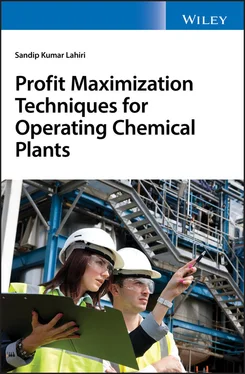1 ...7 8 9 11 12 13 ...19 Running the plant lower that its nameplate design capacity is no longer a viable option and all the plants running at a lower capacity will not be able to cope with stiff international competition and eventually will perish over time. Hence the first and most important step in profit maximization is to know the techniques of how to run the plant at its highest possible capacity. This essentially means:
How to know and exploit the design margin available in installed equipment?
How to know the equipment that is a bottleneck for a further capacity increase?
How to carry out a detailed cost benefit analysis for a major revamp project?
However, the profit maximization project does not end by maximizing the capacity only and involves all the multi‐faceted activities to increase profit in the plant. Following this project an old generation plant can be transformed to a new generation plant. As the scope is vast, this book only addresses some of the proven techniques related to chemical engineering and suggests some alternative innovative ways to generate profit. Some of the ways to increase profits (but are not limited to these) are given below (make a diagram similar to that in Figure 1.2):
Assess existing plant operation and identify and exploit the opportunities to increase profit.
Implement an advance online process monitoring system to monitor equipment and process performance in real time.
Implement a real‐time fault diagnosis system to detect any abnormality of equipment/process at its incipient stage and take preventive and corrective action.
Identify and implement a major debottleneck project.
Utilize a process modeling and simulation technique to optimize process parameters to increase profit.
Identify hidden margins available in major distillation columns and push them to their limit.
Utilize different modeling techniques (data driven or kinetic driven) to generate a model of a major reactor and subsequently optimize reactor parameters to increase profit.
Identify the scope of utility savings and waste reduction to increase profit by implementing them.
Install APC and RTO to stabilize and optimize the process in real time to increase profit amid various disturbances.
1.4 Need for Profit Maximization in Today's Competitive Market
Due to globalization today CPIs have to compete with the global competitive market. The raw material costs of refinery and petrochemicals are varying along with the global crude oil price. Crude oil prices are unpredictable and depend on many complex geo‐political parameters of OPEC and devolved countries. As raw material cost comprises a major component of the product price, profit margins of refineries and petrochemical companies vary in tune with the crude oil price. The final product price of polymers and downstream chemicals are also varying with the crude oil price but the amplitude of variations is not the same as the crude price. Some of the major challenges faced by CPI today are as follows:
Middle East companies (especially those in Saudi Arabia, Qatar, UAE, etc.) and those of China are building plants of world scale capacity, which therefore minimize their production costs. Eight of 10 of the world's largest refineries or petrochemical plants are situated in the Middle East countries or China.
Cheap raw material costs of Middle East companies make them so competitive that companies in other countries find it difficult to compete with them.
Companies have to operate in a global market (both purchase and sales) due to rapid globalization where there are no trade barriers.
Cheap manpower costs of China and SEA companies make them cost effective.
CPI has to fulfill more and more stringent pollution control norms imposed by local pollution control authorities.
Discovery of cheap US shale gas and the building of mega sized refineries and petrochemical factories in the US will change the business map of global competition in the near future as major oil and chemical demands of the US will be satisfied by US companies themselves. This will reduce US demands from China and OPEC countries.
The US may very soon drastically reduce their oil import from OPEC countries and rely on their own oil production. This will change the global oil demand pattern as the US is the major oil importer from Saudi companies. This new oil demand supply equation will affect the crude oil price in an unprecedented way, which may lead to uncertainty in the global crude oil price.
The recent trade war between the US and China will make the polymer and chemical pricing and demand supply scenario uncertain as it evolves.
A faster gross domestic product (GDP) growth rate of the world's top two biggest countries, China and India, will increase demands for polymer and oil, which may shift the global demand pattern into the Asia region in the near future.
Today's CPI has to operate under all of the above uncertain scenarios. Unless it finds an effective mechanism to optimize all the resources that are under its direct control and maximize its profit, it will not generate enough cash to prepare it to deal with uncertain product prices and uneven global competition.
Companies need to be flexible in their product pattern and should have the capability to increase or decrease capacity in tune with global demand. For that companies need to have enough extra cash in hand so that they can use it as a buffer to respond to global business uncertainties.
Implementation of an effective profit maximization project is the only way to generate this buffer money and strategically position the company in a better way to sustain their operation amid global business uncertainties.
1.5 Data Rich but Information Poor Status of Today's Process Industries
With the advent of faster computers in CPI, a large amount of process data is collected and stored every minute by data historian software like IP21, the Pie system, Exaquantum, etc. Every second or minute data of all process parameters of whole plants are now available. This large historical data depository is a distinct feature of today's CPI as compared to older generation plants. These real‐time process data are like an untapped gold mine. Many insights and much process knowledge can be generated from these large sets of operating data. However, very little has been done so far. Due to the unavailability of effective process data analytics, the knowledge hidden in such data could not be tapped properly. The main concerns of CPIs are how to extract meaningful information from these data. Thus, today's chemical industry remains data rich but information poor. There is a need to generate an effective framework where knowledge can be extracted from this wealth of data. Advanced AI based big data analytics systems need to be applied to extract knowledge. The capability to meet this challenge is key for business excellence.
1.6 Emergence of Knowledge‐Based Industries
The speed of technological advancement in the last 20 years makes older technologies obsolete at a speed never before achieved. In today's cut‐throat global competitive environment, companies that follow the old way of doing business gradually become obsolete and die over time. Many chemical companies of the 1980s or 1990snow no longer exist. Companies who could not adopt new technologies and new ways of doing business gradually perish. Only knowledge‐based chemical industries survive. Only CPIs employing knowledge to drive their businesses are going to survive in the future. This essentially means generating an effective platform that can generate knowledge from available business data and use this knowledge to develop a unified framework to support faster business decisions to respond to external market uncertainties. Companies who utilize this knowledge to drive their businesses are called knowledge‐based chemical industries. It is survival of the fittest scenario and only knowledge‐based industries that adapt to a changing business scenario will survive in the future. All other companies, who fail to integrate their knowledge with business, will gradually perish. This gives rise to a new generation of process industries. The emergence of these new generation process industries in this decade is the most important phenomena in CPI.
Читать дальше












